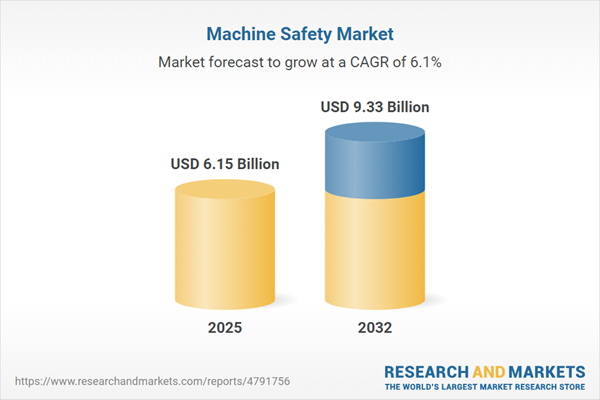Speak directly to the analyst to clarify any post sales queries you may have.
The machine safety market is experiencing a structural transformation as advanced automation, digitalization, and regulatory demands drive manufacturers and industrial operators to prioritize comprehensive safety strategies. The importance of effective machine safeguarding is intensifying across industries navigating new technologies, evolving risks, and persistent compliance requirements.
Market Snapshot: Growth and Strategic Relevance in the Machine Safety Market
The global machine safety market is on a path of steady expansion, with revenues projected to climb from USD 5.80 billion in 2024 to USD 6.15 billion in 2025, and reaching USD 9.33 billion by 2032. This trajectory is supported by a CAGR of 6.11%, underlining the sector's pivotal role in operational risk reduction, workforce protection, and compliance. Growth is driven by technology integration, supply chain pressures, and an increasingly safety-conscious workforce guiding investment and procurement decisions.
Scope & Segmentation: In-Depth Coverage Across Components and Industries
- Component: Emergency stop devices (pull cords, push buttons), safety controllers and relays, safety programmable logic controllers (PLCs), safety sensors and switches (light curtains, safety light bars, safety interlock switches, safety mats and edges), and safety software and monitoring systems.
- Safety Functionality: Access control, emergency stop, presence detection, pressure sensitive devices, speed and motion monitoring, and two-hand control mechanisms.
- Connectivity: Wired safety systems and wireless safety systems enabling flexible installation and operational efficiency.
- Installation Type: Solutions designed for both new installations and retrofit scenarios within existing industrial setups.
- End Use Industry: Automotive (assembly lines, robotics), chemical (bulk and specialty chemicals), food and beverage (packaging, processing), metals and mining, oil and gas (downstream, upstream), pharmaceuticals (manufacturing, R&D), and power generation (fossil fuel, renewable).
- Region: Americas (United States, Canada, Mexico, Brazil, Argentina, Chile, Colombia, Peru), Europe, Middle East & Africa (UK, Germany, France, Russia, Italy, Spain, Netherlands, Sweden, Poland, Switzerland, UAE, Saudi Arabia, Qatar, Turkey, Israel, South Africa, Nigeria, Egypt, Kenya), and Asia-Pacific (China, India, Japan, Australia, South Korea, Indonesia, Thailand, Malaysia, Singapore, Taiwan).
- Leading Companies: ABB Ltd, Banner Engineering Corp., EUCHNER GmbH + Co. KG, IDEC Corporation, K. A. Schmersal GmbH & Co. KG, OMRON Corporation, Pilz GmbH & Co. KG, Rockwell Automation, Inc., Schneider Electric SE.
Key Takeaways: Strategic Insights for Senior Decision-Makers
- Automation and robotics are transforming machine safety into a strategic priority for operational continuity.
- Integration of intelligent sensors and software platforms enables real-time operational risk monitoring and predictive maintenance, supporting proactive risk management.
- Supply chain diversification, including regional partnerships and modular product architectures, is helping companies navigate procurement volatility associated with changing trade policies.
- The shift toward wireless safety systems is accelerating, particularly in retrofit contexts, to provide greater design flexibility and minimize facility disruption.
- Increasing regulatory alignment—such as harmonization with ISO 13849 and IEC 62061—demands broader lifecycle coverage from design to maintenance, making compliance solutions more complex and essential.
- Technological collaboration between global leaders and emerging technology providers is resulting in scalable, integrated safety platforms tailored to sector-specific challenges.
Tariff Impact: Responding to Shifting Trade Environments
Recent United States tariff measures have increased cost and logistics challenges for machine safety equipment reliant on imported components. These pressures are prompting manufacturers to reconsider sourcing strategies, drive supply chain diversification, and accelerate adoption of solutions that support rapid adjustment to evolving trade conditions. Vertically integrated and regionally partnered companies are better positioned to manage these disruptions efficiently.
Methodology & Data Sources
This report’s insights are grounded in a blend of primary research (interviews with engineers, system integrators, and regulatory experts, along with on-site assessments) and secondary research (review of safety standards, white papers, and patent filings). Analytical rigor is ensured through data triangulation, quantitative and qualitative analysis, and peer review by industry specialists.
Why This Report Matters
- Enables decision-makers to proactively mitigate operational and regulatory risks through up-to-date benchmarking and practical strategic recommendations.
- Equips leadership with the market intelligence required to enhance compliance, optimize technology investments, and adapt to shifting supply chain realities.
- Highlights actionable insights into digitalization, workforce training, and partnerships for sustained growth in diverse global markets.
Conclusion
Senior leaders equipped with these insights can steer their organizations toward resilient machine safety practices, effective risk management, and long-term growth in today’s complex global environment. This report supports confident navigation of the evolving machine safety market ecosystem.
Additional Product Information:
- Purchase of this report includes 1 year online access with quarterly updates.
- This report can be updated on request. Please contact our Customer Experience team using the Ask a Question widget on our website.
Table of Contents
3. Executive Summary
4. Market Overview
7. Cumulative Impact of Artificial Intelligence 2025
Companies Mentioned
The companies profiled in this Machine Safety market report include:- ABB Ltd
- Banner Engineering Corp.
- EUCHNER GmbH + Co. KG
- IDEC Corporation
- K. A. Schmersal GmbH & Co. KG
- OMRON Corporation
- Pilz GmbH & Co. KG
- Rockwell Automation, Inc.
- Schneider Electric SE
Table Information
| Report Attribute | Details |
|---|---|
| No. of Pages | 188 |
| Published | November 2025 |
| Forecast Period | 2025 - 2032 |
| Estimated Market Value ( USD | $ 6.15 Billion |
| Forecasted Market Value ( USD | $ 9.33 Billion |
| Compound Annual Growth Rate | 6.1% |
| Regions Covered | Global |
| No. of Companies Mentioned | 10 |









